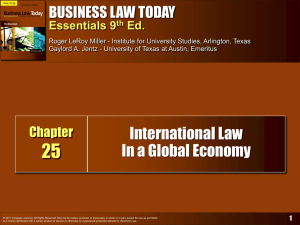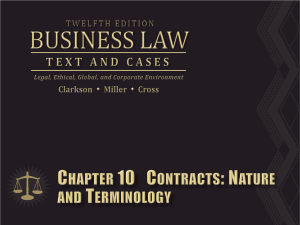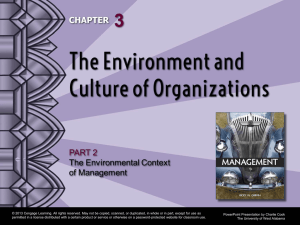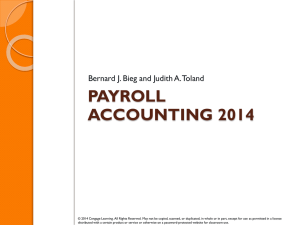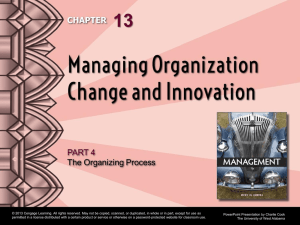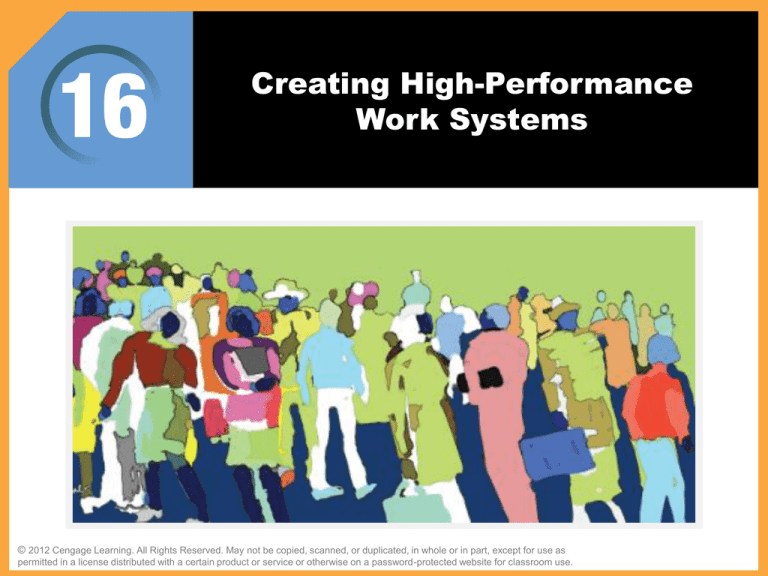
Creating High-Performance
Work Systems
The Challenges of Human Resources Management
© 2012 Cengage Learning. All Rights Reserved. May not be copied, scanned, or duplicated, in whole or in part, except for use as
permitted in a license distributed with a certain product or service or otherwise on a password-protected website for classroom use.
1–1
Chapter Objectives
After studying this chapter, you should be able to
LEARNING OUTCOME 1
Discuss the underlying principles of high performance work
systems.
LEARNING OUTCOME 2
Identify the components that make up a high performance work
system.
LEARNING OUTCOME 3
Describe how the components fit together and support strategy.
LEARNING OUTCOME 4
Recommend processes for implementing high performance work
systems.
LEARNING OUTCOME 5
Discuss the outcomes for both employees and the organization.
© 2012
Learning.
All Rights
Reserved.
May not
be not
copied,
scanned,scanned,
or duplicated,
in whole or in
in whole
part, except
useexcept
as
©
2012Cengage
Cengage
Learning.
All Rights
Reserved.
May
be copied,
or duplicated,
or in for
part,
for use as
permitted
distributed
withwith
a certain
product
or service
or otherwise
on a password-protected
website for classroom
use.
permittedinina alicense
license
distributed
a certain
product
or service
or otherwise
on a password-protected
website for
classroom use.
2 of 32
36
High-Performance Work Systems (HPWS)
• HWPS
Is a specific combination of HR practices, work
structures, and processes that maximizes employee
knowledge, skill, commitment, and flexibility.
Is composed of many interrelated parts that
complement one another to reach the goals of an
organization, large or small.
© 2012
Learning.
All Rights
Reserved.
May not
be not
copied,
scanned,scanned,
or duplicated,
in whole or in
in whole
part, except
useexcept
as
©
2012Cengage
Cengage
Learning.
All Rights
Reserved.
May
be copied,
or duplicated,
or in for
part,
for use as
permitted
distributed
withwith
a certain
product
or service
or otherwise
on a password-protected
website for classroom
use.
permittedinina alicense
license
distributed
a certain
product
or service
or otherwise
on a password-protected
website for
classroom use.
3 of 32
36
© 2012
Learning.
All Rights
Reserved.
May not
be not
copied,
scanned,scanned,
or duplicated,
in whole or in
in whole
part, except
useexcept
as
©
2012Cengage
Cengage
Learning.
All Rights
Reserved.
May
be copied,
or duplicated,
or in for
part,
for use as
permitted
distributed
withwith
a certain
product
or service
or otherwise
on a password-protected
website for classroom
use.
permittedinina alicense
license
distributed
a certain
product
or service
or otherwise
on a password-protected
website for
classroom use.
4 of 32
36
© 2012
Learning.
All Rights
Reserved.
May not
be not
copied,
scanned,scanned,
or duplicated,
in whole or in
in whole
part, except
useexcept
as
©
2012Cengage
Cengage
Learning.
All Rights
Reserved.
May
be copied,
or duplicated,
or in for
part,
for use as
permitted
distributed
withwith
a certain
product
or service
or otherwise
on a password-protected
website for classroom
use.
permittedinina alicense
license
distributed
a certain
product
or service
or otherwise
on a password-protected
website for
classroom use.
5 of 32
36
Fundamental Principles
• Egalitarianism and Engagement
Egalitarian work environments eliminate status and
power differences and, in the process, increase
collaboration and teamwork.
When this happens, productivity can improve if people
who once worked in isolation from (or opposition to)
one another begin to work together.
© 2012
Learning.
All Rights
Reserved.
May not
be not
copied,
scanned,scanned,
or duplicated,
in whole or in
in whole
part, except
useexcept
as
©
2012Cengage
Cengage
Learning.
All Rights
Reserved.
May
be copied,
or duplicated,
or in for
part,
for use as
permitted
distributed
withwith
a certain
product
or service
or otherwise
on a password-protected
website for classroom
use.
permittedinina alicense
license
distributed
a certain
product
or service
or otherwise
on a password-protected
website for
classroom use.
6 of 32
36
Fundamental Principles (cont.)
• Shared Information
A shift away from the mentality of command and
control toward one more focused on employee
commitment.
Creating a culture of information sharing where
employees are more willing (and able) to work toward
the goals for the organization.
© 2012
Learning.
All Rights
Reserved.
May not
be not
copied,
scanned,scanned,
or duplicated,
in whole or in
in whole
part, except
useexcept
as
©
2012Cengage
Cengage
Learning.
All Rights
Reserved.
May
be copied,
or duplicated,
or in for
part,
for use as
permitted
distributed
withwith
a certain
product
or service
or otherwise
on a password-protected
website for classroom
use.
permittedinina alicense
license
distributed
a certain
product
or service
or otherwise
on a password-protected
website for
classroom use.
7 of 32
36
Fundamental Principles (cont.)
• Knowledge Development
Employees in high-performance work systems need to
learn in “real time,” on the job, using innovative new
approaches to solve novel problems
The number of jobs requiring little knowledge and skill
is declining while the number of jobs requiring greater
knowledge and skill is growing rapidly.
© 2012
Learning.
All Rights
Reserved.
May not
be not
copied,
scanned,scanned,
or duplicated,
in whole or in
in whole
part, except
useexcept
as
©
2012Cengage
Cengage
Learning.
All Rights
Reserved.
May
be copied,
or duplicated,
or in for
part,
for use as
permitted
distributed
withwith
a certain
product
or service
or otherwise
on a password-protected
website for classroom
use.
permittedinina alicense
license
distributed
a certain
product
or service
or otherwise
on a password-protected
website for
classroom use.
8 of 32
36
Fundamental Principles (cont.)
• Performance-Reward Linkage
It is important to align employee and organizational
goals. When rewards are connected to performance,
employees will naturally pursue outcomes that are
mutually beneficial to themselves and the organization.
© 2012
Learning.
All Rights
Reserved.
May not
be not
copied,
scanned,scanned,
or duplicated,
in whole or in
in whole
part, except
useexcept
as
©
2012Cengage
Cengage
Learning.
All Rights
Reserved.
May
be copied,
or duplicated,
or in for
part,
for use as
permitted
distributed
withwith
a certain
product
or service
or otherwise
on a password-protected
website for classroom
use.
permittedinina alicense
license
distributed
a certain
product
or service
or otherwise
on a password-protected
website for
classroom use.
9 of 32
36
© 2012
Learning.
All Rights
Reserved.
May not
be not
copied,
scanned,scanned,
or duplicated,
in whole or in
in whole
part, except
useexcept
as
©
2012Cengage
Cengage
Learning.
All Rights
Reserved.
May
be copied,
or duplicated,
or in for
part,
for use as
permitted
distributed
withwith
a certain
product
or service
or otherwise
on a password-protected
website for classroom
use.
permittedinina alicense
license
distributed
a certain
product
or service
or otherwise
on a password-protected
website for
classroom use.
10 of 32
36
Complementary Human Resources
Policies and Practices
Training and
Development
Staffing Practices
Compensation
© 2012
Learning.
All Rights
Reserved.
May not
be not
copied,
scanned,scanned,
or duplicated,
in whole or in
in whole
part, except
useexcept
as
©
2012Cengage
Cengage
Learning.
All Rights
Reserved.
May
be copied,
or duplicated,
or in for
part,
for use as
permitted
distributed
withwith
a certain
product
or service
or otherwise
on a password-protected
website for classroom
use.
permittedinina alicense
license
distributed
a certain
product
or service
or otherwise
on a password-protected
website for
classroom use.
11 of 32
36
Management Processes and Leadership
• Success of any high-performance work system
depends on first changing the roles of managers and
team leaders
• With fewer layers of management and a focus on
team-based organization, the role of managers and
supervisors is substantially different in an environment
of high-performance work systems.
• Managers and supervisors are seen more as coaches,
facilitators, and integrators of team efforts.
© 2012
Learning.
All Rights
Reserved.
May not
be not
copied,
scanned,scanned,
or duplicated,
in whole or in
in whole
part, except
useexcept
as
©
2012Cengage
Cengage
Learning.
All Rights
Reserved.
May
be copied,
or duplicated,
or in for
part,
for use as
permitted
distributed
withwith
a certain
product
or service
or otherwise
on a password-protected
website for classroom
use.
permittedinina alicense
license
distributed
a certain
product
or service
or otherwise
on a password-protected
website for
classroom use.
12 of 32
36
Supportive Information Technologies
• Must be added to the framework of high performance
work systems
• Sharing information vital to business performance
• High-performance work systems cannot succeed without
timely and accurate communications
• Typically the information needs to be about business
plans and goals, unit and corporate operating results,
incipient problems and opportunities, and competitive
threats
© 2012
Learning.
All Rights
Reserved.
May not
be not
copied,
scanned,scanned,
or duplicated,
in whole or in
in whole
part, except
useexcept
as
©
2012Cengage
Cengage
Learning.
All Rights
Reserved.
May
be copied,
or duplicated,
or in for
part,
for use as
permitted
distributed
withwith
a certain
product
or service
or otherwise
on a password-protected
website for classroom
use.
permittedinina alicense
license
distributed
a certain
product
or service
or otherwise
on a password-protected
website for
classroom use.
13 of 32
36
© 2012
Learning.
All Rights
Reserved.
May not
be not
copied,
scanned,scanned,
or duplicated,
in whole or in
in whole
part, except
useexcept
as
©
2012Cengage
Cengage
Learning.
All Rights
Reserved.
May
be copied,
or duplicated,
or in for
part,
for use as
permitted
distributed
withwith
a certain
product
or service
or otherwise
on a password-protected
website for classroom
use.
permittedinina alicense
license
distributed
a certain
product
or service
or otherwise
on a password-protected
website for
classroom use.
14 of 32
36
© 2012
Learning.
All Rights
Reserved.
May not
be not
copied,
scanned,scanned,
or duplicated,
in whole or in
in whole
part, except
useexcept
as
©
2012Cengage
Cengage
Learning.
All Rights
Reserved.
May
be copied,
or duplicated,
or in for
part,
for use as
permitted
distributed
withwith
a certain
product
or service
or otherwise
on a password-protected
website for classroom
use.
permittedinina alicense
license
distributed
a certain
product
or service
or otherwise
on a password-protected
website for
classroom use.
15 of 32
36
Testing the Alignment of the HR system
with HR Deliverables (cont.)
© 2012
Learning.
All Rights
Reserved.
May not
be not
copied,
scanned,scanned,
or duplicated,
in whole or in
in whole
part, except
useexcept
as
©
2012Cengage
Cengage
Learning.
All Rights
Reserved.
May
be copied,
or duplicated,
or in for
part,
for use as
permitted
distributed
withwith
a certain
product
or service
or otherwise
on a password-protected
website for classroom
use.
permittedinina alicense
license
distributed
a certain
product
or service
or otherwise
on a password-protected
website for
classroom use.
16 of 32
36
Testing the Alignment of the HR system
with HR Deliverables (cont.)
© 2012
Learning.
All Rights
Reserved.
May not
be not
copied,
scanned,scanned,
or duplicated,
in whole or in
in whole
part, except
useexcept
as
©
2012Cengage
Cengage
Learning.
All Rights
Reserved.
May
be copied,
or duplicated,
or in for
part,
for use as
permitted
distributed
withwith
a certain
product
or service
or otherwise
on a password-protected
website for classroom
use.
permittedinina alicense
license
distributed
a certain
product
or service
or otherwise
on a password-protected
website for
classroom use.
17 of 32
36
Fitting It All Together
• The HR Scorecard
Assessing Internal fit
– Do all internal elements of the HR system complement
and reinforce one another?
Assessing HR Practices
– Do HR practices significantly enable key workforce
deliverables such as employment stability and
teamwork?
Assessing External Fit
– Are workforce deliverables connected with key strategic
performance drivers?
© 2012
Learning.
All Rights
Reserved.
May not
be not
copied,
scanned,scanned,
or duplicated,
in whole or in
in whole
part, except
useexcept
as
©
2012Cengage
Cengage
Learning.
All Rights
Reserved.
May
be copied,
or duplicated,
or in for
part,
for use as
permitted
distributed
withwith
a certain
product
or service
or otherwise
on a password-protected
website for classroom
use.
permittedinina alicense
license
distributed
a certain
product
or service
or otherwise
on a password-protected
website for
classroom use.
18 of 32
36
Implementing the System
• Necessary Actions for a Successful HPWS:
Ensure that change is owned by senior and line managers.
Allocate sufficient resources and support for the
change effort.
Ensure early and broad communication.
Ensure that teams are implemented in a systemic context.
Establish methods for measuring the results of change.
Ensure continuity of leadership and champions of
the initiative.
© 2012
Learning.
All Rights
Reserved.
May not
be not
copied,
scanned,scanned,
or duplicated,
in whole or in
in whole
part, except
useexcept
as
©
2012Cengage
Cengage
Learning.
All Rights
Reserved.
May
be copied,
or duplicated,
or in for
part,
for use as
permitted
distributed
withwith
a certain
product
or service
or otherwise
on a password-protected
website for classroom
use.
permittedinina alicense
license
distributed
a certain
product
or service
or otherwise
on a password-protected
website for
classroom use.
19 of 32
36
Implementing High-Performance Work Systems
© 2012
Learning.
All Rights
Reserved.
May not
be not
copied,
scanned,scanned,
or duplicated,
in whole or in
in whole
part, except
useexcept
as
©
2012Cengage
Cengage
Learning.
All Rights
Reserved.
May
be copied,
or duplicated,
or in for
part,
for use as
permitted
distributed
withwith
a certain
product
or service
or otherwise
on a password-protected
website for classroom
use.
permittedinina alicense
license
distributed
a certain
product
or service
or otherwise
on a password-protected
website for
classroom use.
20 of 32
36
Building Cooperation with Unions
© 2012
Learning.
All Rights
Reserved.
May not
be not
copied,
scanned,scanned,
or duplicated,
in whole or in
in whole
part, except
useexcept
as
©
2012Cengage
Cengage
Learning.
All Rights
Reserved.
May
be copied,
or duplicated,
or in for
part,
for use as
permitted
distributed
withwith
a certain
product
or service
or otherwise
on a password-protected
website for classroom
use.
permittedinina alicense
license
distributed
a certain
product
or service
or otherwise
on a password-protected
website for
classroom use.
21 of 32
36
Navigating the Transition to High-Performance
Work Systems
• Navigating the Transition
Ongoing activity - never fully completed
Best results occur when managers and employees
work together
The top down approach communicates manager
support and clarity, while the bottom-up approach
ensures employees accept and are committed to
the approach
• Building a Transition Structure
Establishing an implementation plan that provides a
timetable and process for mapping key business
processes, redesigning the work flow, and training
employees can keep the effort from bogging down
© 2012
Learning.
All Rights
Reserved.
May not
be not
copied,
scanned,scanned,
or duplicated,
in whole or in
in whole
part, except
useexcept
as
©
2012Cengage
Cengage
Learning.
All Rights
Reserved.
May
be copied,
or duplicated,
or in for
part,
for use as
permitted
distributed
withwith
a certain
product
or service
or otherwise
on a password-protected
website for classroom
use.
permittedinina alicense
license
distributed
a certain
product
or service
or otherwise
on a password-protected
website for
classroom use.
22 of 32
36
Incorporating the HR Function as a
Valuable Partner
• Recruiting, evaluation, and reward systems
devised by HR groups can have a huge impact
on how well high-performance work systems are
implemented.
• HR managers are in a good position to help
employees in transition handle what they are
going through
© 2012
Learning.
All Rights
Reserved.
May not
be not
copied,
scanned,scanned,
or duplicated,
in whole or in
in whole
part, except
useexcept
as
©
2012Cengage
Cengage
Learning.
All Rights
Reserved.
May
be copied,
or duplicated,
or in for
part,
for use as
permitted
distributed
withwith
a certain
product
or service
or otherwise
on a password-protected
website for classroom
use.
permittedinina alicense
license
distributed
a certain
product
or service
or otherwise
on a password-protected
website for
classroom use.
23 of 32
36
Evaluating and Sustaining the Success
of the System
• Process Audit – Questions?
Are employees actually working together, or is the
term “team” just a label?
Are employees getting the information they need to
make empowered decisions,
and are they engaged?
Are training programs developing the knowledge and
skills employees need?
Are employees being rewarded for good performance
and useful suggestions?
Are employees treated fairly so that power differences
are minimal?
© 2012
Learning.
All Rights
Reserved.
May not
be not
copied,
scanned,scanned,
or duplicated,
in whole or in
in whole
part, except
useexcept
as
©
2012Cengage
Cengage
Learning.
All Rights
Reserved.
May
be copied,
or duplicated,
or in for
part,
for use as
permitted
distributed
withwith
a certain
product
or service
or otherwise
on a password-protected
website for classroom
use.
permittedinina alicense
license
distributed
a certain
product
or service
or otherwise
on a password-protected
website for
classroom use.
24 of 32
36
Evaluating and Sustaining the Success
of the System (cont.)
• Is the program succeeding? – Questions?
Are the behaviors the organization desires being
exhibited on the job?
Are quality, productivity, flexibility, and customer service
objectives being met?
Are quality-of-life goals being achieved for employees?
Is the organization more competitive than in the past?
• Implementing an HPWS is one thing. Sustaining
it is another.
© 2012
Learning.
All Rights
Reserved.
May not
be not
copied,
scanned,scanned,
or duplicated,
in whole or in
in whole
part, except
useexcept
as
©
2012Cengage
Cengage
Learning.
All Rights
Reserved.
May
be copied,
or duplicated,
or in for
part,
for use as
permitted
distributed
withwith
a certain
product
or service
or otherwise
on a password-protected
website for classroom
use.
permittedinina alicense
license
distributed
a certain
product
or service
or otherwise
on a password-protected
website for
classroom use.
25 of 32
36
© 2012
Learning.
All Rights
Reserved.
May not
be not
copied,
scanned,scanned,
or duplicated,
in whole or in
in whole
part, except
useexcept
as
©
2012Cengage
Cengage
Learning.
All Rights
Reserved.
May
be copied,
or duplicated,
or in for
part,
for use as
permitted
distributed
withwith
a certain
product
or service
or otherwise
on a password-protected
website for classroom
use.
permittedinina alicense
license
distributed
a certain
product
or service
or otherwise
on a password-protected
website for
classroom use.
26 of 32
36
© 2012
Learning.
All Rights
Reserved.
May not
be not
copied,
scanned,scanned,
or duplicated,
in whole or in
in whole
part, except
useexcept
as
©
2012Cengage
Cengage
Learning.
All Rights
Reserved.
May
be copied,
or duplicated,
or in for
part,
for use as
permitted
distributed
withwith
a certain
product
or service
or otherwise
on a password-protected
website for classroom
use.
permittedinina alicense
license
distributed
a certain
product
or service
or otherwise
on a password-protected
website for
classroom use.
27 of 32
36
Outcomes of High-Performance Work Systems
• Employee Outcomes and Quality of Work Life
More involved in work
More satisfied and find that needs for growth are more
fully met
More informed and empowered, feel that they have a
fuller role to play in the organization and that their
opinions and expertise are valued more
Have a greater commitment that comes from higher
skills and greater potential for contribution
© 2012
Learning.
All Rights
Reserved.
May not
be not
copied,
scanned,scanned,
or duplicated,
in whole or in
in whole
part, except
useexcept
as
©
2012Cengage
Cengage
Learning.
All Rights
Reserved.
May
be copied,
or duplicated,
or in for
part,
for use as
permitted
distributed
withwith
a certain
product
or service
or otherwise
on a password-protected
website for classroom
use.
permittedinina alicense
license
distributed
a certain
product
or service
or otherwise
on a password-protected
website for
classroom use.
28 of 32
36
Outcomes of High-Performance
Work Systems (cont.)
• Organizational Outcomes and Competitive
Advantages
Higher productivity
Lower costs
Better responsiveness to customers
Greater flexibility
Higher profitability
© 2012
Learning.
All Rights
Reserved.
May not
be not
copied,
scanned,scanned,
or duplicated,
in whole or in
in whole
part, except
useexcept
as
©
2012Cengage
Cengage
Learning.
All Rights
Reserved.
May
be copied,
or duplicated,
or in for
part,
for use as
permitted
distributed
withwith
a certain
product
or service
or otherwise
on a password-protected
website for classroom
use.
permittedinina alicense
license
distributed
a certain
product
or service
or otherwise
on a password-protected
website for
classroom use.
29 of 32
36
Organizational Outcomes and
Competitive Advantages
• Competencies in must have the following qualities:
Valuable: High-performance work systems increase value
by establishing ways to increase efficiency, decrease
costs, improve processes, and provide something unique
to customers.
Rare: High-performance work systems help organizations
develop and harness skills, knowledge, and abilities that
are not equally available to all organizations.
Difficult to imitate: High-performance work systems are
designed around team processes and capabilities that
cannot be transported, duplicated, or copied by rival firms.
Organized: High-performance work systems combine the
talents of employees and rapidly deploy them in new
assignments with maximum flexibility.
© 2012
Learning.
All Rights
Reserved.
May not
be not
copied,
scanned,scanned,
or duplicated,
in whole or in
in whole
part, except
useexcept
as
©
2012Cengage
Cengage
Learning.
All Rights
Reserved.
May
be copied,
or duplicated,
or in for
part,
for use as
permitted
distributed
withwith
a certain
product
or service
or otherwise
on a password-protected
website for classroom
use.
permittedinina alicense
license
distributed
a certain
product
or service
or otherwise
on a password-protected
website for
classroom use.
30 of 32
36
Key Terms
•
•
•
•
•
high-performance work system
(HPWS)
internal fit
external fit
process audit
© 2012
Learning.
All Rights
Reserved.
May not
be not
copied,
scanned,scanned,
or duplicated,
in whole or in
in whole
part, except
useexcept
as
©
2012Cengage
Cengage
Learning.
All Rights
Reserved.
May
be copied,
or duplicated,
or in for
part,
for use as
permitted
distributed
withwith
a certain
product
or service
or otherwise
on a password-protected
website for classroom
use.
permittedinina alicense
license
distributed
a certain
product
or service
or otherwise
on a password-protected
website for
classroom use.
31 of 32
36
Chapter 16 - Learning Outcomes
Learning Outcome Statements
Related Outcomes from Body of the Text
1
Discuss the underlying principles of high
performance work systems.
This textbook has emphasized the goals of competing through people,
getting the best from employees, treating them fairly, and building an
excellent organization. What key points have you learned in this regard,
and how do they tie together in your mind when it comes to managing
human resources?
2
Identify the components that make up a high
performance work system.
Consider the chapters in this book. How do you think the topics of each
one tie in with high-performance work systems? Are there any chapters
that do not?
3
Describe how the components fit together and
support strategy.
Have you ever moved a piece of furniture in your house or dorm room
and noticed that once you did, everything else needed to be moved, too?
How do you think this same principle might work when it comes to highperformance work systems?
4
Recommend processes for implementing high
performance work systems.
What obstacles do you think managers might face when implementing a
high-performance work system?
5
Discuss the outcomes for both employees and
the organization.
As an employee, how do you think a high performance work system
might benefit you personally? What drawbacks might you experience
because of such a system?
© 2012
Learning.
All Rights
Reserved.
May not
be not
copied,
scanned,scanned,
or duplicated,
in whole or in
in whole
part, except
useexcept
as
©
2012Cengage
Cengage
Learning.
All Rights
Reserved.
May
be copied,
or duplicated,
or in for
part,
for use as
permitted
distributed
withwith
a certain
product
or service
or otherwise
on a password-protected
website for classroom
use.
permittedinina alicense
license
distributed
a certain
product
or service
or otherwise
on a password-protected
website for
classroom use.
32 of 32
36


